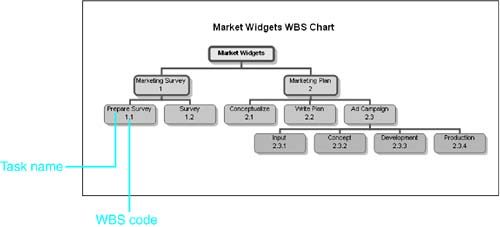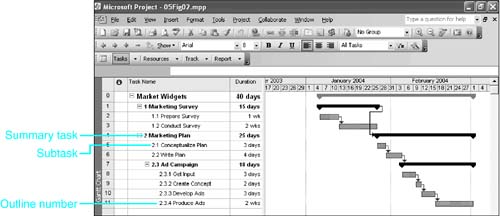Approaching the Planning Process
| < Day Day Up > |
| After securing approval for a concise but comprehensive goal statement that defines the scope of a project, your next major planning function is to draw up a list of activities, or tasks , that must be completed to achieve the project goal.
There are two basic approaches to creating a task list : the top-down approach and the bottom-up approach. In the top-down approach, you start by listing the major phases of the project. Then you indent under each major phase the detail tasks that make it possible to complete the phase. The phase then becomes what is called a summary task, and the indented detail tasks are called subtasks . This method is probably the most common approach to project planning, and it provides an outlined organizational structure that helps people comprehend the scope of the project. In the bottom-up approach, you begin by listing all the task details. Although it is not required, many people prefer to have the list in a somewhat chronological order. If your project is not too complex, the list might be adequate for understanding the scope of the project. However, for more complex projects, you might need to organize the task list into an outline, so that the end result is similar to the result produced by the top-down approach. Outlining produces an organizational form that is functionally identical to the organizational chart format that is traditionally used by project managers and that is called the Work Breakdown Structure (WBS). As shown in Figure 5.1, the WBS identifies major components of a project and shows multiple levels of detail under each major component. WBS codes are traditionally used to number each task in such a way that the code identifies where the task fits into the project's hierarchical structure. In Microsoft Project these codes are by default identical to the outline numbers that are automatically provided for each task. The outline numbers (the default WBS codes) are shown before each task name in Figure 5.2. Figure 5.1. WBS diagrams organize project tasks into phases or functional groups that help visualize the scope of the project. Figure 5.2. Project's outline numbers can be used as WBS codes; you can also edit the WBS codes to customize them.
An outline is not necessary for a complete project plan. However, outlining has many advantages and can significantly enhance a plan's flexibility and usefulness as a planning and reporting tool:
A task list contains three main types of tasks:
|
| < Day Day Up > |
EAN: 2147483647
Pages: 283

